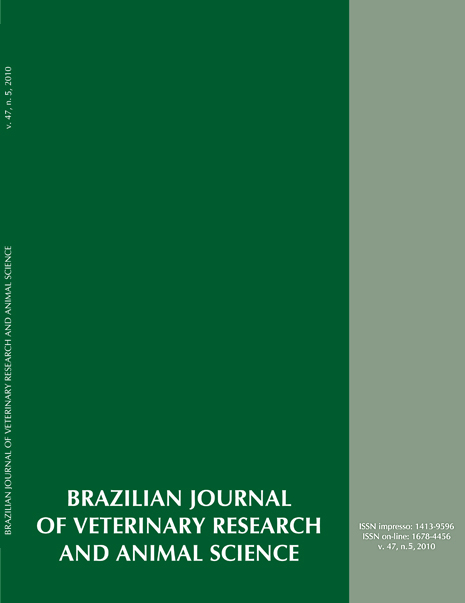Development of the leptospirosis by experimental infection in hamsters (Mesocricetus auratus) with Leptospira interrogans serovar Canicola, strain LO4, by intact and scratched skin exposures
DOI:
https://doi.org/10.11606/issn.1678-4456.bjvras.2010.26814Keywords:
Leptospiorosis, Experimental infection, Hamster, Skin exposure, Serovar Canicola (LO4 strain)Abstract
The establishment and evolution of leptospirosis in hamster (Mesocricetus auratus) by experimental infection with Leptospira interrogans serovar Canicola, LO4 strain, by intact and scratched skin exposures, having as control the intraperitoneal route, were evaluated. Hundred-twenty female hamsters distributed in two groups according to inoculation route (intact and scratched skin) were used. Infectious inoculum was constituted by a pure culture of L. interrogans serovar Canicola (strain LO4), isolated from liver from a slaughtered swine in Londrina, Paraná state and typified by agglutinins adsortion technique with monoclonal antibody kit at the Royal Tropical Institute, Amsterdam, the Netherlands. The animals were observed twice a day during 21 days. Animals that died were necropsied and kidneys, liver, genital tract (uterus and ovaries) and brain were aseptically collected. On the 21st post-inoculation day, surviving animals were euthanized. In these animals, serum samples were also collected by cardiac puncture to antileptospires agglutinins research using microscopic agglutination test (MAT). Fresh direct microscopy and microbiological culture were used for the detection of leptospires. Scratched skin route induced larger lethality when compared to intact skin route, with establishment and evolution of leptospirosis. On the other hand, intact skin route induced renal and/or genital carrier state more frequently. LO4 strain presented low immunogenic power, characterized by soroconversion at the MAT in only one inoculated animal.Downloads
Download data is not yet available.
Downloads
Published
2010-10-01
Issue
Section
UNDEFINIED
License
The journal content is authorized under the Creative Commons BY-NC-SA license (summary of the license: https://
How to Cite
1.
Batista C de SA, Azevedo SS de, Vasconcellos SA, Castro V, Figueiredo SM de, Alves CJ, et al. Development of the leptospirosis by experimental infection in hamsters (Mesocricetus auratus) with Leptospira interrogans serovar Canicola, strain LO4, by intact and scratched skin exposures. Braz. J. Vet. Res. Anim. Sci. [Internet]. 2010 Oct. 1 [cited 2024 Nov. 23];47(5):346-51. Available from: https://revistas.usp.br/bjvras/article/view/26814





